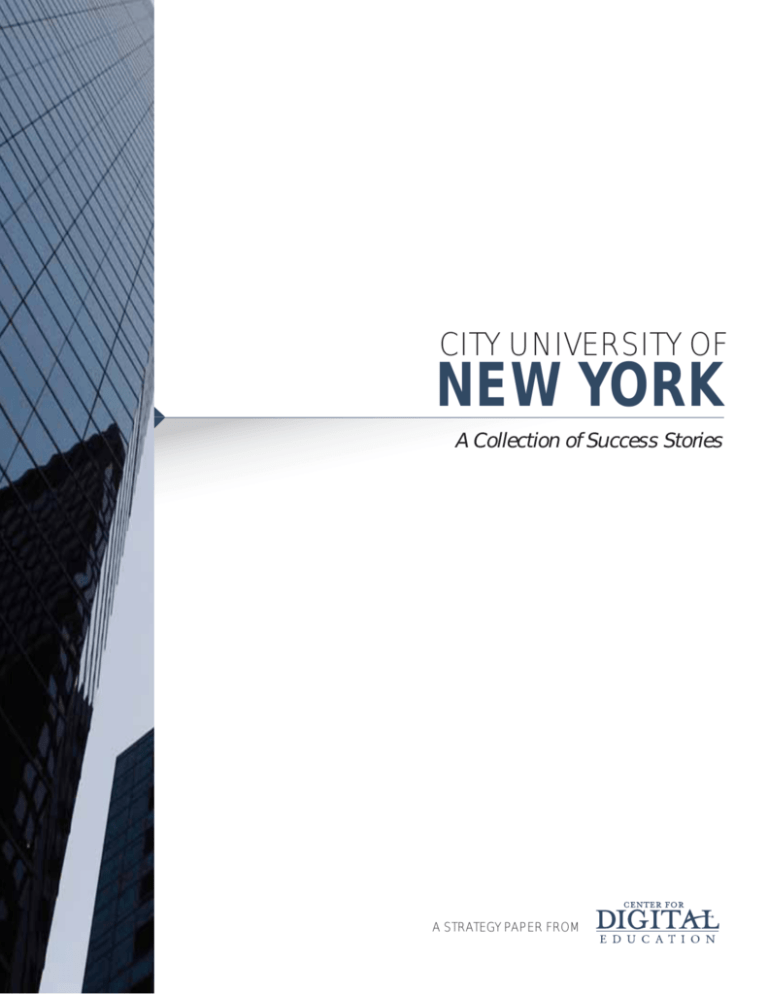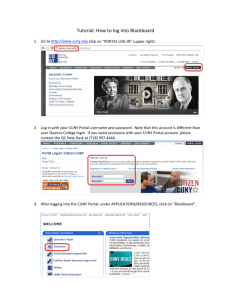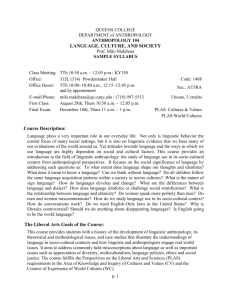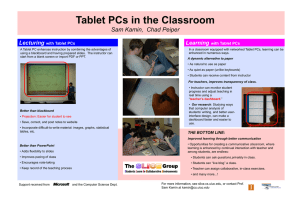
CITY UNIVERSITY OF
NEW YORK
A Collection of Success Stories
A STRATEGY PAPER FROM
INTRODUCTION —WHY TABLET PCS?
THE CUNY VISION
The City University of New York (CUNY), working with
Intel, Agilix Labs, Inc. HP, Blackboard and Microsoft, spent
six months exploring the possibilities of Tablet PCs in higher
education. CUNY, the nation’s largest urban university with
more than 450,000 degree-credit students enrolled at 11 senior
colleges, six community colleges and three post-graduate
schools, offered a wide variety of academic settings in which
to explore the Tablets.
Tablet PCs make sense for colleges and universities. They
not only leverage all the benefits of complete mobility (for
commuter and resident students alike) but they provide for the
maximization of other university technology investments.
The idea for a Tablet PC implementation began with
a conversation about transformation within CUNY. Intel
and CUNY were both interested in exploring a project that
could make an impact in the world of higher education. To
foster excitement about this potential transformation and
to accelerate the use of technology in classroom, CUNY
partnered with five companies to make a difference in the way
students learn and instructors teach.
The vision borne from the groups’ meeting was an image of
more convenient and advanced education: commuter students
with Tablet PCs in hand could log into a program on their
computer that works with additional software to synchronize
course information and assignments. This program would
automatically populate a students’ Tablet PC any time a
professor updated their data using the same software.
This new vision of education presented a student-centered
learning tool that coincided with curriculum and promised to
enhance the learning process. The Tablet PC was one piece of the
vision that allowed all technological benefits to coalesce and work
best on behalf of students. It was imperative that the technology
benefit students because all CUNY students commute and
Blackboard and Agilix software had the potential to put students
a tremendous advantage.
James Haggard, deputy CIO of CUNY, thought the
Tablet PCs were interesting technology and wanted to see
how they could impact learning. “I wanted to get people
thinking about this new technology and how it fits into the
university setting,” says Haggard. “To do this, we had to
get it in the hands of the faculty and students.” Haggard
explains that each of the four participating campuses was
encouraged to structure the pilot in the way that best fit
its particular academic setting. Bronx Community College,
College of Staten Island and Queens College selected
classroom environments; John Jay School of Criminal
Justice selected a post-graduate research project.
The four pilot projects on the various CUNY campuses
offered an opportunity to further explore how to build
continuous value in Blackboard and Agilix. The Tablet
PC pilot was a vital action toward maximizing CUNY’s
ongoing commitment to its students via technology.
CUNY’S VISION
Expand Offerings
CUNY wants to increase your offerings beyond what is
possible and/or affordable with conventional educational
delivery systems. This ensures that the university system will
continue to attract and keep more students by increasing
the value of its programs.
Enhanced Learning Experience;
Better Lectures and Presentations
CUNY knows that technology can help hold the attention
of learners during lectures and presentations and that a
commitment to appropriately use various media to enhance
learning rather than just entertain is an effective strategy.
Make CUNY Competitive with
the Best in the World
By building a strategic plan and implementing strategic
programs, CUNY will continue to set a standard for other
universities in the use and availability of education materials
and information technology.
p_2
THE PARTNERS
This project brought together numerous technology
partners, some for the first time. Throughout the project, the
partners worked to create a technical environment that would
allow CUNY to investigate this new technology. “We wanted
to create excitement around integrating Tablet technology into
the classroom, but we also wanted to transform learning and
teaching to be a collaborative, interactive, student-centered
activity,” says Melanie Fekete, Education Programs Manager
for Intel Americas. Intel provided funding and assisted in
organizing the project. Agilix Labs contributed both GoBinder
and GoBinder Mobilizer. Blackboard and Agilix Labs worked
together to interface CUNY’s existing learning management
system, Blackboard, with Agilix’s GoBinder application
through GoBinder Mobilizer, allowing students access to
electronic course material while away from the CUNY campus.
GoBinder lets students take notes, download instructor lectures
and annotate directly on electronic documents. HP provided
the Tablet PCs to CUNY at a heavily discounted price.
Microsoft also provided funding and contributed Windows
XP, Office and OneNote. OneNote, Microsoft’s note-taking
and management program, allows users to organize notes and
share information in meetings, presentations, brainstorming
sessions, phone conferences and classes.
INSTITUTIONAL GOALS AND VISION FOR TABLET TECHNOLOGY
Goal
Why It Matters
Classroom &
Institution
Management
You want the grading and paperwork
Staten Island
processes of teaching to be easier and more
automated. Students and faculty should be
able to do self-service on classroom and institutional processes. You want to know the results
of your specific programs and effort with as
much cause and effect analysis as possible.
You want your learners to learn using the
John Jay College
same tools, techniques, and systems they
Bronx College
will use in the workplace.
Reflect Work
Conditions
Who Did It
Collaborative Learning You want your learners to work in
collaborative teams and networks that are
not bound by the walls and grounds of
your campus or region.
Queens College
SUCCESS STORIES
The Partners
Intel Centrino,
Mobile Technology,
Agilix,
HP,
Blackboard,
Microsoft
Intel Centrino,
Mobile Technology,
Agilix,
HP,
Blackboard,
Microsoft
Intel Centrino,
Mobile Technology,
Agilix,
HP,
Blackboard,
Microsoft
p_3
SUCCESS STORIES
College of Staten Island
The College of Staten Island (CSI) is a senior college within
CUNY, awarding associate, bachelor’s and master’s degrees.
Staten Island professor William Bernhardt had been using
HP Tablets and Agilix GoBinder for about one year and
was familiar with the unique features offered by this solution.
Bernhardt recognized the potential in English and composition
classes and was eager to try the technology. For the pilot, CSI
selected its online freshman composition course, focusing on
three basic goals crucial to freshman-level composition:
• Improve students’ active reading for online assignments using
annotation features of the Tablet and GoBinder.
• Enhance peer interaction, especially for purposes of
sharing reading notes and feedback on essay drafts and
other assignments.
• Enhance editing and proof-reading for both instructors and
students using the digital ink capability.
Students were offered the solution for the duration of the
course. Many students already had computers, therefore the
Tablets were optional. Seven students used the Tablets.
Students were excited about using the Tablet PCs and the
additional capabilities GoBinder provided. Mobility, note taking
functionality and the ability to comment directly on documents
were among the favorite features of the solution.
According to Bernhardt, “The students were excited about
being able to bring material from Blackboard (and other Webbased content) into GoBinder on their Tablets for work offline, as
some had slow or no Internet access from their home or job.“
Bernhardt continues, “The students utilized GoBinder for
document capture, mark-up and note-taking in connection
with course assignments, which most of them were enthusiastic
about. I found the quality of their pen annotations (markup and
short comments) markedly superior to the work of comparable
individuals in the same class who were annotating some of
the same documents in a word processing environment with a
keyboard and mouse.”
Bernhardt explains that making the documents available to
students without GoBinder’s mobilization and print functions was
“considerably more labor-intensive from an instructor’s point of
view.” He also noted that the solution made many of his tasks
easier, especially grading and annotating assignments submitted
and returned electronically. “I can make tick marks in the margins
indicating there was something in that line for the student to
correct,” he says. “I can also draw attention to words and sentence
construction in ways that I can’t do with a regular PC.”
Staten Island continued the project through the summer
with similar success and is currently looking for ways to expand
the use of Tablets in other courses.
DEC 2004
p_4
JAN 2005
JAN-MAY 2005
SEPT 2005
p,
pu
P
Re roje
po ct
rti W
ng ra
Tr
Eq ain
ui Fa
pm cu
en lty
t, , O
In rd
st er
al
lS
of
tw
Br
ar
e
Pi on
lo x,
ts S
Be tat
gi en
n
Is
la
nd
Jo
hn
Ja
yP
ilo
tB
eg
in
Q
s
St uee
at n
en s P
Is ro
la je
nd ct
, B Be
ro gi
nx ns
Co ,
nt
in
ue
Pr
o
je
ct
In
iti
at
io
n
IMPLEMENTATION TIMELINE
NOV-DEC 2005
Bronx Community College
Bronx Community College is a two-year college that
serves more than 6,000 students. It offers a variety of degrees
and certificate programs emphasizing allied health careers,
technological training and the sciences. James Kenelly,
executive director of Information Technology at Bronx
Community College (BCC), saw the Tablet PC pilot as a
way to build the college’s honors program and recognize the
students enrolled in the program. “I wanted to introduce the
technology on campus while bringing visibility to our honors
critical in the music course, where a traditional PC or laptop
is clumsy at best. The Tablet’s mobility, compact size, light
weight and the wireless Internet access on campus and ability
to work offline through GoBinder all contributed to the
students’ positive responses and satisfaction.
Queens College
Queens College, located in Flushing, Queens, has almost
17,000 undergraduate and graduate students. Queens trains
students to think critically, address complex problems, explore
various cultures and use modern technologies and information
“I wanted to introduce the technology on campus resources.
The Tablet project was a great fit for college freshman
while bringing visibility to our honors program and
world studies. Dr. Helen Gaudette, acting director of College
recognizing the students who choose to do the
Preparatory Programs and adjunct lecturer in History,
extra work required by the program.”
explains that this course is different from traditional courses.
“The class uses reactive learning, where students react to
James Kenelly, executive director of Information Technology,
historical events recreated in the classroom through research,
Bronx Community College.
debates and papers,” Gaudette explains. In this course,
students work in teams and are required to collaborate to
program and recognizing the students who choose to do the
form and articulate positions on historical events.
extra work required by the program,” said Kenelly.
In the Spring 2005 semester, four faculty members and
20 honors students (GPA 3.2 or better) were given Tablet “The Tablet allows instructors to move around the
PCs and training. The students enrolled in at least one of classroom while lecturing and still have access to
four courses offered by participating faculty members from the computer.”
History, English, Music, and Communication Arts. Bronx
Sue Henderson, vice president for Institutional Advancement,
participants used OneNote as the note management system Queens College.
rather than GoBinder. To provide students information and
support, project coordinators created an electronic forum in
Tablets were provided to all students in the class. With
Blackboard. The forum allowed participants to communicate
heavy emphasis on collaboration, the Tablets and Blackboard
and provided program information and tutorials. BCC faculty
became tools for creating online communities within student
also conducted training workshops and hosted several lunch
teams. According to Gaudette, the students’ work habits
meetings, bringing the group together in an informal setting
changed. Groups of students clustered together with their
to address problems and issues related to the project.
Tablets, using the tools to create position papers, develop
At the conclusion of the semester, project coordinators
newspapers from the historical period and communicate.
held a focus group to assess:
Because the equipment arrived in the middle of
• the Tablet PC as a teaching/learning tool;
the Spring 2005 semester, Queens decided to loan the
• lessons learned from the pilot project; and
equipment to faculty members while waiting for the full
• possible future use of Tablets for the BCC honors program. pilot to start in the fall. Sue Henderson, vice president for
Student responses to the technology were overwhelmingly Institutional Advancement at Queens College, said mobility
positive. In fact, one student believed the Tablet PC was in the classroom was a big plus for the faculty members.
“equal to the invention of the telephone” in its significance “The Tablet allows instructors to move around the classroom
to students. The honors students also enjoyed the recognition while lecturing and still have access to the computer,” says
— Tablets clearly identified their academic achievement. Henderson.
Queens plans to expand its use of Tablets in the future.
Students liked the ability to write directly on electronic
Henderson
is eager to thoroughly investigate how the
documents, whether taking notes, revising papers or
commenting on assignments. They were also excited about technology impacts student learning.
the ability to draw on the Tablet screen. This was especially
p_5
John Jay College of Criminal Justice
John Jay College of Criminal Justice is internationally
recognized as a leader in criminal justice education and
research. The college offers undergraduate and graduate
programs to more than 14,000 students.
The college selected its United Nations/Interpol Crime
Data Analysis project as the Tablet PC case study. A team of
13 faculty members and graduate students (both master’s and
doctorate level) was tasked with validating the data reported
to the United Nations on violent crimes in member nations.
Coordinating a project with team members traveling
across the nation is difficult. “The best way get faculty to
work together is to create a center point where they can easily
connect and have a really long tether,” says John Jay professor
and lead technology team member Peter Mameli. To
accomplish this objective, each team member was provided a
Tablet PC for the duration of the project. A dedicated project
space was created in Blackboard, allowing easy sharing of all
project information, including coordination and review of
data and the final report.
“I consider the Tablet project a success.”
Peter Mameli, Public Administration professor,
John Jay College of Criminal Justice.
The common collaboration space accessible from any
Internet connection was hugely valuable to the team. The
light weight and mobility of the Tablets, coupled with the
ease of connecting with all members of the team, helped the
group produce a quality report for the United Nations. “The
United Nations was happy with our report, so I consider the
Tablet project a success,” asserts Mameli.
While the U.N. research project did not require field
interviews, Mameli saw this as an area where the unique features
of the Tablet would be a benefit in future research projects.
The John Jay pilot did highlight a caution to those interested
in investigating new technology. The most common technologyrelated activities of the project – processing and analyzing
data, and writing and editing reports – did not require the
unique features of the Tablets. Therefore, many advantages
of the Tablets such as note-taking, peer review and document
annotation were not apparent to some team members.
p_6
LESSONS LEARNED AND NEXT STEPS
CUNY’s leadership is excited about the success of the
project. “We are just beginning to understand how powerful
the Tablet is in the university setting,” says Haggard. “The
Tablet project got the technology into the hands of our
faculty and students and helped them understand how they
can use the Tablets.”
“CUNY is a laboratory equipped to demonstrate different
applications of the Tablet PC,” explains Colette Wagner,
former project manager for CUNY. The breadth of projects
reflects the wide diversity of CUNY’s campuses and programs
and provides an opportunity to examine many possibilities
of the Tablets. Both faculty and students were enthusiastic.
The Tablets eased note-taking, provided faculty mobility in
the classrooms and easier assignment grading, improved peer
review for papers, and provided participants the ability to
work away from campus. The Tablets lent themselves well to
subjects such as music and art where drawing is much more
useful than typing. Undergraduate students valued the ability
of Tablets to integrate written notes with class handouts.
One challenge for the project team members was
the extremely compressed project timeline. It introduced
challenges with organizing case studies, acquiring hardware,
obtaining approval for human subject research and installing
and testing software components. The vendor partners
and CUNY staff worked hard to overcome the challenges
introduced by the short deadline. When CUNY Deputy CIO
James Haggard was asked what he would do differently, he
responded that next time it would be essential to give people
more time and more exposure ahead of time to the technology
“We are just beginning to understand how powerful the Tablet is in the university setting.”
James Haggard, deputy CIO, CUNY.
so when it came time for classroom use, participants would
have a better understanding of the resources they have
available at their disposal.
CUNY plans to apply the lessons learned from these case
studies and expand its Tablet use throughout the campuses.
“Next we want to look at ways the technology can be better
used in the classrooms,” Haggard explains, “and how we
can effectively integrate the Tablets into course curriculum.”
Another important step for Haggard is to publicize what
has been done at CUNY and inform educators about the
potential of technology resources.
PARTNERS
®
www.intel.com/education
www.blackboard.com
Intel’s Focus on Education:
Today, a good education and proficiency in information and
communications technology (ICT) go hand-in-hand. Students
need technology proficiency to succeed in today’s workplace,
and technology facilitates an interactive, student-centered
approach to learning that allows students to develop critical
skills necessary for today’s knowledge-based economy — skills
like problem solving, critical thinking, and collaboration.
Today, schools, districts and education agencies in 37 states
use the power of Blackboard software technology to: extend
classroom instruction online, enhance professional development,
create web-based instructional alternatives and augment parentteacher communication. Blackboard delivers complementary
solutions to K-12 institutions — all tied together by a strong
commitment to ease of use, flexibility, interoperability and
ongoing implementation support services.
To further technology’s role in enhancing education, Intel
concentrates efforts in these key areas: improving teaching and
learning, preparing students for success in the knowledge-based
economy in collaboration with governments and educators
worldwide, accelerating ICT adoption in education, and
increasing the worldwide adoption of technology-enriched
teaching and learning solutions that improve education.
Find out how Blackboard can help your district transform the
Internet into a powerful tool for teaching and learning. Call
1.800.424.9299. Or visit www.blackboard.com.
www.agilix.com
Agilix Labs, Inc. is a worldwide leader in mobile learning
solutions for education markets. Education institutions
that implement Agilix solutions deliver an enhanced
student-centered learning environment. Specifically, Agilix
applications enable students to utilize mobile computing
devices to capture, organize, annotate, search and share
learning content, including assignments, online courses,
research, Web pages, documents and personal notes without
being connected to a network.
A privately held company formed in 2001, Agilix is based in
Orem, Utah. For more information about Agilix Labs, please
visit www.agilix.com or contact us at 801.932.1234.
www.microsoft.com/education
Founded in 1975, Microsoft Corporation is the worldwide
leader in software, services and Internet technologies for
personal and business computing. For more than 10 years,
Microsoft has been dedicated to providing the education
community with industry-leading solutions that enable a
dynamic, engaging, and collaborative learning environment
powered by Microsoft technology. Microsoft is making
Connected Learning Communities a reality with costeffective solutions that help educators build modern learning
infrastructures, providing anytime, anyplace access to
resources and integrate technology into classroom instruction
and school administration. Visit with Microsoft staff to
experience how these solutions can become a reality within
your classroom.
www.education.hp.com
The new HP means innovation for Education. INNOVATION
is the power to deliver personalized learning anytime, anywhere
through powerful wireless ACCESS devices, imaging and printing
tools, and the best-selling ENTERPRISE products. Innovation
in SERVICES gives you the power to manage learning, not
technology. Call 1-800-88-TEACH and get innovative.
p_7
© 2006 e.Republic.
All rights reserved.
100 Blue Ravine Road
Folsom, CA 95630
916.932.1300 phone
916.932.1470 fax
www.centerdigitaled.com
Acknowledgements:
Liz Wallendorf, Senior Fellow, Center for Digital Education
and former policy and planning administrator for the city of Tucson
The Center for Digital Education is a national research and advisory institute
on K-12 and Higher Education technology. Its custom events, publishing,
online resources and advisory services are tailored for
private industry and public education leaders.
The Center is a business division of e.Republic, publisher of Converge Online,
Government Technology magazine and Public CIO.






